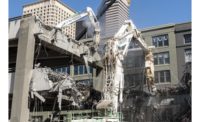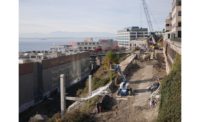Washington State Dept. of Transportation Alaskan Way Tunnel Design Build
Seattle
Best Project, Highway/Bridge
Owner: Washington State Dept. of Transportation
Lead Design Firm & Civil, Structural & MEP Engineer: HNTB Corp.
General Contractor: Seattle Tunnel Partners (Joint Venture of Dragados USA Inc. and Tutor Perini Inc.)
Seattle drivers went from meandering over portions of downtown via the seismically vulnerable State Route 99 Alaskan Way Viaduct to whizzing under the city’s busy streets through a $1.3-billion deep-bored passageway when the SR 99 tunnel opened in February.
Reaching 200 ft deep at its lowest point and excavated at 57.5 ft in diameter, the Washington State Dept. of Transportation-owned tunnel—dug by the boring machine Bertha—is the country’s largest soft-ground bored tunnel and the flagship segment of the larger $3.3-billion Alaskan Way Viaduct Replacement program, one of the nation’s largest-ever infrastructure projects.
“Not only is the tunnel an important milestone in transportation history, it also demonstrates how transportation infrastructure can work in harmony with the physical environment to usher in a new era of safety, environmental control and aesthetic integration into the surrounding city,” says Brian Russell, HNTB engineer and lead tunnel designer.
Although the project wasn’t without hiccups—the Japanese-made tunnel-boring machine (TBM) overheated and broke down just 11% of the way into the bore, causing a nearly two-year underground repair program—the work progressed smoothly for the final three years of the project, including most of the 1.7 miles of tunneling.
“While the project certainly had its challenges, there were many lessons learned that could benefit other cities,” says Brian Nielsen, the project’s administrator for WSDOT and now the agency’s deputy regional administrator for the Northwest region.
“Ultimately, the SR 99 tunnel is a model for megaprojects and mega-tunnels in urban areas. Now that the country’s only double-decker highway tunnel is open, we are pleased to report it is performing as promised, carrying tens of thousands of vehicles each day safely through downtown Seattle,” Nielsen says.
The size and scope of the project—in the planning stages for nearly two decades and officially started in 2011—was entirely new to Russell.
“I don’t think I have ever been on a billion-plus-dollar project before, and the enormity of the undertaking and the schedule—and the fact that it was a design-build project with a lot of complexities—was daunting for us as engineers to mobilize staff and the resources needed to meet the schedule requirements to get the construction started,” he says.
That said, the HNTB team tapped into knowledge from previous jobs, overall company expertise and experts from Europe with experience in tunneling. While the coordination across international offices was challenging, what concerned Russell most was the soil.
“Our biggest worry and biggest effort were to come up with a plan to launch the machine and tunnel deep enough underground to get to soils where the machine could do its job and avoid ground loss,” Russell says.
The project started and finished in downtown Seattle, tunneling under 157 buildings along the way. In the beginning, engineers focused on protecting structures, and after the work reached deeper soil conditions, contractor Seattle Tunnel Partners—a joint venture between Dragados USA and Tutor Perini Corp.—also focused on avoiding ground loss by installing tunnel liners and filling voids with grout throughout the boring process.
“The advancement in tunneling technology is key to the future,” Russell says. “The innovations by the contractor in terms of being able to build something repetitive and with repetitive quality, I think a lot of those construction techniques are really overlooked but are really important.”
Crews installed battered micropiles to form a canopy over the tunnel. The piles supported foundations, while carbon fiber reinforcement of existing viaduct-beam sections added capacity for the still-in-use roadway structure, allowing differential settlement without damage.
“Many of the design challenges were new, since a tunnel of this size with its required safety features had never been built before,” Russell says. “The project included an advanced seismic design for the tunnel liner and interior roadways, and complex mechanical and electrical systems unique to tunnels.”
Creating 32-ft-wide roadways to carry two southbound lanes on top of two northbound lanes required plenty of materials and synchronized construction. Crews built the tunnel about 500 ft behind the TBM, sequenced to keep operations moving and compress the schedule.
The project used precast concrete tunnel segments for the liners, precast panels for the northbound roadway decks, precast bridge girders at the north end of the tunnel and cast-in-place concrete for drilled shafts and roadway structures.
“The quantity of concrete placed under the logistical constraints of working underground, under a tight schedule and with high-quality expectations, is a true triumph of collaboration and advanced planning,” Russell says.
The completed tunnel features 1,152 panels for the double-deck roadway and 16 electrical rooms spaced along the alignment to control lights, cameras and operation of 9,270 ft of electrical, mechanical and plumbing.
The 95 miles of wiring, 21 miles of sprinkler pipes, 15 miles of lights, 13 miles of fiber-optic cables and eight miles of heat detectors are interconnected with a safety system that uses cameras and electronic sensors to monitor conditions in the tunnel.
If needed, the system can shift traffic patterns or go into emergency mode and activate jet fans to pull in fresh air using wall louvers to ventilate the tunnel. The tunnel also includes a separate safety corridor.
The system samples air every few seconds to detect an increase in emissions, while the fire-suppression system has eight miles of fiber-optic heat sensors in the ceilings.
If a sensor is triggered, the fans activate and the system notifies tunnel staff. Divided into more than 100 unique safety zones, the system can pinpoint sections and activate sprinklers while staff use cameras to determine additional steps.
“Building the SR 99 tunnel and tearing down the old Alaskan Way Viaduct was, at its core, a public safety project,” says Nielsen. “The SR 99 tunnel is designed to withstand a strong earthquake—unlike the seismically vulnerable viaduct that previously carried SR 99 through downtown Seattle. We accomplished our goal of tearing down the viaduct before another major earthquake hit the Pacific Northwest.”
And through it all, Nielsen says the project created little disruption to the public. “Seattle’s SR 99 tunnel project proved that large cities can find new traffic solutions,” he says. “We built a tunnel large enough to support a double-deck highway underneath a major city and kept traffic moving above during construction.”
By opening the tunnel in February, WSDOT was able to turn to the final piece of the Alaskan Way Viaduct Replacement project and remove the double-decker concrete viaduct that opened in 1953.
Not only did demolition of the structure remove a seismic risk from the downtown core, it also opened up the Seattle waterfront and paved the way for future projects to redevelop the waterfront.
Russell says the tunnel operationally has worked not only to prove that megaprojects are still possible, but also to change the way people move through a major downtown.
“It has allowed the city of Seattle to really develop the waterfront and change the downtown core,” he says. “I actually drove it many times just to see how well it worked. It is just amazing how long it is, but how fast I get through downtown.”
Related Article: ENR Northwest's 2019 Best Project Winners Highlight Regional Diversity








Post a comment to this article
Report Abusive Comment